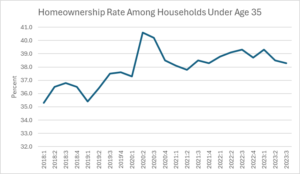December 15, 2023
In keeping with its apparent commitment to ignore the data and insist homeownership is no longer possible, the New York Times ran yet another piece on how homeownership is becoming impossible for young people. The piece begins with the sad story of a young woman worried whether she and her spouse will ever be able to own a home.
“Cameron Ambrosy spent the first weekend of December going to 10 open houses — purely for research purposes. The 25-year-old in St. Paul, Minn., has a well-paying job and she and her husband are saving diligently, but she knows that it will be years before they can afford to buy.
“‘It is much more of a long-term goal than for my parents or my grandparents, or even my peers who are slightly older,’ said Ms. Ambrosy, adding that for many of her friends, homeownership is even farther away. ‘There’s a lot of nihilism around long-term goals like home buying.’”
It is unfortunate to hear about this nihilism. It would have been helpful to note that it does not correspond to the data. While homeownership rates have fallen back somewhat in the last few quarters, as a result of the sharp jump in mortgage rates, they are still above the pre-pandemic levels.
This is true across the board, including for young people. The graph below shows the homeownership rate for households under age 35.

Source: Census Bureau, Table 6.
Note that in the most recent quarter, the homeownership rate for households under 35 was 38.3 percent, which is up from 37.6 percent in the fourth quarter of 2019, the last quarter before the pandemic.[1] That was when Donald Trump was still in the White House and the New York Times was not running article after article about how young people could not afford to buy houses.
Let me just repeat this point for the benefit of any elite types that might be reading this. The New York Times has repeatedly run pieces on the impossibility of homeownership for young people during the Biden administration. It did not run pieces on the impossibility of homeownership among young people when the homeownership rate was lower during the Trump administration.
Now, there is clearly an issue at the moment with high mortgage rates, but mortgage rates always fluctuate, and even the article notes that they have already fallen and are likely to fall further in the near future. It would be a bit bizarre for someone to have little hope of owning a home for long into the future based on a short-term rise in mortgage rates that is already being reversed.
If mortgage rates follow the 10-year Treasury bond rate downward, and the extraordinarily large gap between the 30-year mortgage rate and the 10-year Treasury bond rate is reduced, we may be looking at mortgage rates below 6.0 percent before long. That’s still somewhat higher than the pre-pandemic rate, but not high by historic standards.
The piece also talks about the runup in rents. This is undoubtedly a big deal for young people, since they are twice as likely to be renters as the rest of the population. However, it would be worth pointing out that rental inflation has pretty much stopped and rents may actually be falling.
Indexes of apartments that come on the market are now showing that rents have leveled off over the last half year. This slowdown in rental inflation will eventually show up in the government data, however, there is a lag, since the government rental indexes include all rental units, not just the ones that turn over. However, people actively looking for an apartment would be benefitting now from the lower inflation, or even falling rents.
It may well be the case that young people see a huge crisis in the housing market, but in that case the story should be how their perceptions are so much at odds with the reality, not an article that wrongly implies the reality is horrible.
[1] The big jump in ownership rates in 2020 was likely an artifact of the shutdown, when response rates to the survey plunged. (Correction: It has been pointed out to me that the 2020 rise was due to young people moving back in with their families during the pandemic. This reduced the number of households, raising the share who were homeowners.)







Comments